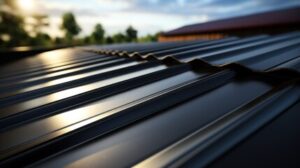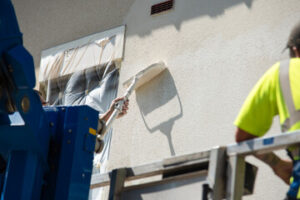Gutters (also known as eavestrough, rain gutters, and guttering) protect your home from water damage and enhance its curb appeal. They’re essential for preventing expensive basement flooding and rotting siding.

Water that pools around your house can cause mold, mildew and pests. It can also weaken your foundation walls and crack basement floors. Gutters prevent this by directing rainwater to designated areas. Contact Gutters Gainesville FL for professional help.
Gutters are a drainage system that prevents mold, mildew and other water damage to your home. Attached to your roofline, gutters guide rainwater and melting snow away from the building’s foundation. They also help to keep soil erosion from harming your garden and walkways. Gutters work even better when they’re properly maintained.
A gutter is a series of troughs attached to your roof’s fascia board, where they collect and discharge rainwater. The water then flows through a downspout, which sits vertically on the edge of your house. The bottom opening of the downspout is angled to dispense the water on the ground or into an underground drainage system.
Without functioning gutters, water would build up over the walls and fascia boards. Over time, this can lead to rot in the soffit, fascia and shingles. It could also cause moisture damage to windows and sills, as well as mold in the drywall and masonry. Gutters also help to keep moisture from damaging your foundation, which can weaken it and cause cracks.
However, the only way to harness your gutters’ protective power is to keep them free of debris and clogs. Clogged gutters lead to stagnant water, which breeds mosquitoes, termites and other pests that like to feed on organic material. In addition, leaking gutters can cause water damage to your house and make it unsafe for your family to live in.
Gutter cleaning is a relatively simple job that can be done by yourself or with the help of a professional. It involves removing leaves, twigs, and other debris that can block the flow of water. It also includes checking your gutters for signs of sagging, leaks, or other problems. Keeping up with your gutter maintenance prevents the need for costly repairs or replacements.
Gutters are a necessary feature for any home, especially in climates that receive frequent rainfall or significant snowfall. Properly maintained gutters direct rainwater and melting snow away from your foundation, preventing basement flooding, foundation damage, and other water-related issues. Regular cleaning and inspections also ensure that your gutters are directing water far enough from your foundation to avoid eroding soil around the home’s foundation.
They prevent mold and mildew
Gutter systems serve a vital function by directing rainwater away from your home’s foundation and walls. If this is not done, your home can be at risk for flooding and water damage, especially in the basement area. Gutters also prevent mold and mildew from growing in your home, which can pose health risks for you and your family.
Mold is a fungus that grows in moist, humid environments and spreads through airborne spores. It is a serious problem for homeowners, and it can cause a variety of problems, including respiratory issues and rotting of building materials. Regular gutter cleaning and maintenance can reduce the likelihood of mold growth. However, if mold and mildew are already present, it is important to take steps to remove it as quickly as possible.
Clogged gutters can lead to excessive moisture around the building’s walls, foundation, and siding, creating a breeding ground for mold. This excess moisture can cause structural problems and lead to costly repairs. It can also lead to the breakdown of building materials and rot, as well as create a damp environment for people to live in. This can be very dangerous for children and pets.
Keeping your gutters clean is an important part of maintaining the value of your property. It can be difficult to do on your own, but it is important to hire a professional to ensure the job is done correctly. Gutter cleaning services can include a full inspection of your gutter system, including downspouts and downpipes. They can also offer advice on how to maintain your gutters.
Gutters are an essential feature of any home. They protect the roof and the surrounding areas from damage. Without them, a house is at risk of water damage, mold growth, and flooding in the basement. A good quality gutter system can last for years and improve the overall appearance of your home.
In areas that experience frequent heavy rainfall, gutters can get clogged, leading to water retention and promoting the growth of mildew. Clogged gutters can even lead to water seeping into a building’s walls and basement, which can lead to extensive damage. Regular gutter maintenance and inspections can help prevent these problems.
They prevent pests
Keeping your gutters clean is an essential part of maintaining the integrity of your roof and home. If you don’t do so, pests can take up residence in your gutters. This can result in a variety of issues, including structural damage to your roof and walls, rotting wood, and insect infestations. In addition, if pests find their way into your house, they can create health hazards for you and your family, including itchy mosquito bites and disease-causing rodent droppings.
Gutter cleaning is an easy, cost-effective preventative measure against a host of unwanted pests. You should also consider trimming overhanging tree branches, as they can act as a highway for pests to travel to your gutters. Aside from preventing overgrowth, this will reduce the amount of debris that ends up in your gutters and can help prevent water leaks.
Clogged gutters provide a warm and safe spot for pests like mice, squirrels, and raccoons to make their homes. Their scurrying around your home’s attic is a clear sign of an unwelcome intruder, and their droppings can lead to rotted gutters and chimneys, as well as health risks for you and your pets.
Standing water in clogged gutters provides the perfect breeding ground for mosquitoes. They can lay up to 200 eggs at a time in the damp, undisturbed environment. Mosquitoes are known carriers of disease-causing pathogens and can cause itchy, irritating bites on humans and pets. Other pests that find their way into clogged gutters include carpenter ants, termites, centipedes, and millipedes. Infestations of these insects can lead to costly roof repairs and structural damage.
Bees, wasps, and hornets may nest in clogged gutters as well. Their hives can weigh down and even pull down gutters, and their stings can be dangerous for your family.
Regular gutter cleaning and installing protective guards can prevent pests from making their homes in your gutters. You can also use natural deterrents, such as plants that repel pests or a mixture of vinegar and diluted essential oils. This helps to keep your gutters pest-free, without exposing you or your family to chemicals.
They increase your home’s value
A well-maintained gutter system is a significant selling point when it comes to your home’s value. This is because they help to protect the roof, siding, windows, foundation, and landscaping from water damage. This can save you thousands of dollars in costly repairs and restorations. In addition, a well-functioning gutter system can also prevent mold, mildew, soil erosion, and pests from infiltrating your house.
A gutter is a pipe that’s attached to the fascia and sits at a slight angle to direct rainwater away from your home. It’s often made of metal or plastic and is one of the most important parts of a house’s roof system. If it’s not in good condition, it can cause expensive water damage to the shingles, foundation, and basement. In addition, a damaged gutter can lead to leaks and cracks in the shingles and the siding of your house.
Besides protecting the interior of your house from mold, mildew, and wood rot, gutters also help to maintain the resale value of your property. A gutter with a good design, which is easy to clean and install, can make your home look more attractive. This can attract potential buyers and increase your home’s resale value.
Gutters can be made from a variety of materials, such as steel, copper, vinyl, or aluminum. However, it’s important to choose a gutter that is durable and will not rust or crack over time. You can also add additional features to your gutter, such as screens, filters, or guards, which will help keep it free of debris and minimize maintenance costs.
Although gutters are not the most glamorous home improvement projects, they are an essential part of your roof’s protection system. When it’s properly installed and maintained, a gutter can prevent structural damage to your home’s walls and foundation, and can even stave off moisture problems that attract mold, mildew, and pests. A well-functioning gutter system can also extend the lifespan of your roof and improve your home’s curb appeal. If you’re considering getting a new gutter system, it’s important to work with an experienced company to ensure that your investment is worth the money.

